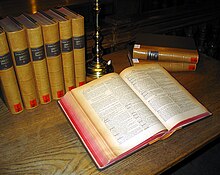Wikipedia:WikiProject Wikipack Africa Content/Wikipedia:Citing sources
| This page in a nutshell: Wikipedia's Verifiability policy requires inline citations for any material challenged, or likely to be challenged, and for all quotations, anywhere in article space. |

Telling people where the information and facts that are put into articles comes from is an important part of Wikipedia. You should add a citation for the sources of information. To make a citation, or cite a fact means to quote by example, to give authority, and to provide proof.[1] This helps to make sure the facts are right and can be verified (checked to make sure that the information comes from somewhere and so is true) by the readers.
If someone sees that there is information in an article that does not have a source, then the information may be removed.
The sources used should be trustworthy and from a reliable source. The information should be distributed by a special group that is well-known for checking their own facts as well, making sure the information is correct or true.
On the article page, you should list in numerical order where the facts come from in a section called "References".
If you use citations inside the article paragraphs (this is preferred), then you need to set up the article references section with
== References ==
{{reflist}}
Inline source citations use tags in the form of <ref> reference information here </ref> . Inline citations are often placed at the end of a sentence or paragraph immediately following the sentence punctuation mark. When using inline source citations with tags, the sources listed in the References section will be automatically numbered.
Templates
[edit]Using templates to format citations makes sure that the information in the citation is complete and useful to the reader. Three commonly used citation templates are {{Cite web}}, {{Cite book}} and {{Cite news}}. Click on them to see the full details of all the information that can be included. There are many other citation templates.
Common templates
[edit]The mostly commonly used parameters to use an inline citation with the {{Cite web}} template (using the current date) are:
<ref>{{cite web |url= |title= |accessdate=2025-01-11 |last= |first= |coauthors= |date= |format= |work= |publisher= |pages= |quote= }}</ref>
The most commonly used parameters to use an inline citation with the {{Cite book}} are:
<ref>{{cite book |title= |last= |first= |authorlink= |coauthors= |year= |publisher= |location= |isbn= |pages= |url= |accessdate= }}</ref>
The most commonly used parameters to use an inline citation with the {{Cite news}} are:
<ref>{{cite news |title= |first= |last= |newspaper= |date= |url= |accessdate= }}</ref>
When quoting someone
[edit]You should always add a reference when quoting published material. You should always include the page number if there is one. The reference should be placed either right after the quotation
- Example: "This is a quotation".[1]
or after a sentence or expression that introduces the quotation.
- Example: Jane Austen spoke of novels as follows:[2]
Some statements are from reliable sources. However, they are different from one another. When this happens, the text should clearly say where the opinions came from.
- Example: Martin Davis has described some of Burgin's claims as "misleading".[2]
When writing about living persons
[edit]Statements about living persons should be sourced very carefully. This is important for legal and ethical reasons. If there is a statement that a living person did something bad, it must cite a reliable source. If you find unsourced or poorly sourced material like this about a living person, whether in an article or on a talk page, remove it immediately! Do not leave it in the article while you request a source. Do not move it to the talk page. Wikipedia articles about people (biographies) or any other materials follow this rule.
Circular sourcing
[edit]Sometimes, other people (and books and websites) copy from Wikipedia. This means that the source cannot be trusted to support statements in articles, because it could create "circular" sourcing. We depend on sources to check their facts; using a source which is based on Wikipedia will bypass that check. There can also be copyright problems. Do not use sources which copied their information from Wikipedia. Also, do not use Wikipedia itself (in any language) as a source.
Text–source integrity
[edit]When using inline citations, it is important to maintain text–source integrity. The point of an inline citation is to allow readers and other editors to check that the material is sourced. That point is lost if the citation is not clearly placed. The distance between material and its source is a matter of editorial judgment, but adding text without clearly placing its source may lead to allegations of original research, of violations of the sourcing policy, and even of plagiarism. Generally the source citation directly follows the punctuation mark (usually the period at the end of a sentence).
Editors should exercise caution when rearranging or inserting material to ensure that text–source relationships are maintained. In particular, if a sentence or paragraph is cited with a source, adding material to that sentence which is not supported by the source is highly misleading. When new text is inserted into a paragraph, make sure it is supported. For example:
The sun is pretty big.[1] The sun is also quite hot.[2]
Notes
Do not add other facts or assertions into a fully cited paragraph or sentence:

The sun is pretty big, but the moon is not so big.[1] The sun is also quite hot.[2]
Notes
Include a source to support the new information. There are several ways to write this, including:

The sun is pretty big,[1] but the moon is not so big.[2] The sun is also quite hot.[3]
Notes
References
[edit]- ^ "Cite". Merriam-Webster's Collegiate(R) Dictionary. 2004. Retrieved 5 November 2011.
- ^ Davis, Martin (2006). "The Church–Turing Thesis: Consensus and opposition", Proceedings, Computability in Europe 2006. Lecture notes in computer science, pp. 125–32.
